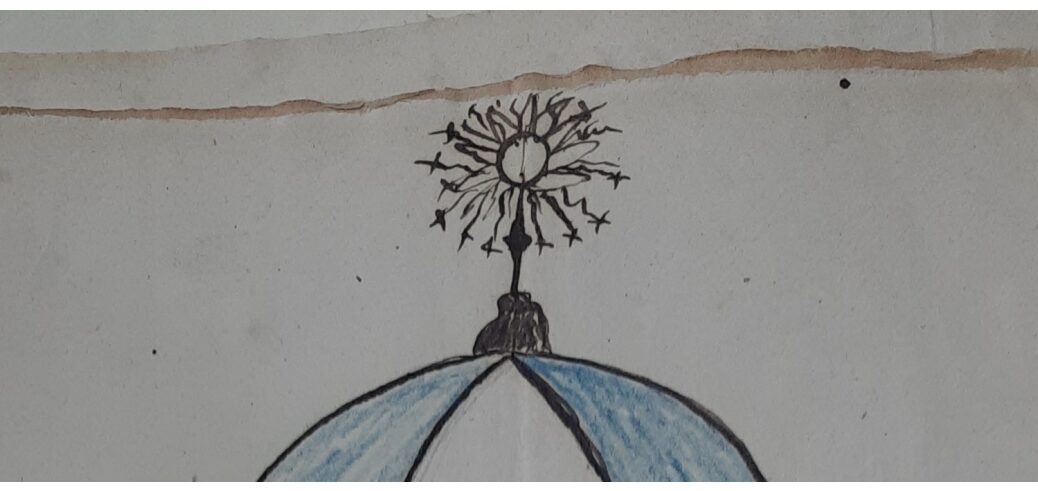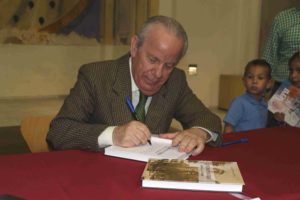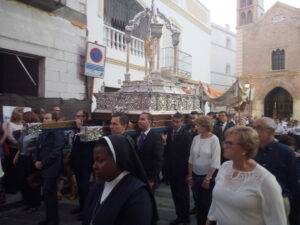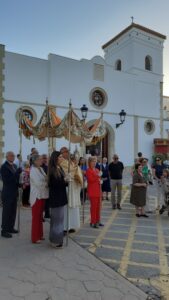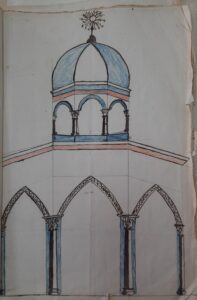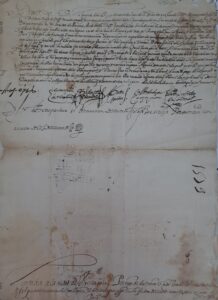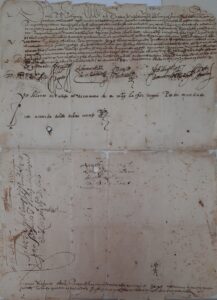Artículo escrito por Gabriel Flores Garrido, cronista oficial de Vera (Almería). Includes English version at the end. Includes English version at the end (elaborada por Francisco Javier Martínez Castro).
CORPUS CHRISTI: FIESTA GRANDE DESDE EL SIGLO XVI
Tal vez la festividad del Corpus, próxima a celebrarse, sea un buen motivo para comenzar mi labor, desde el puesto de cronista oficial de Vera, que generosamente me ha sido asignado.
Por su significado para el mundo católico, constituyendo uno de los pilares de su fe, por su coincidencia en el tiempo con el nombramiento mencionado y por la tradición de su celebración, que nuestra ciudad ha mantenido a través de los siglos, es por lo que he visto este hecho apropiado para comenzar con la divulgación de festividades, momentos, lugares y acontecimientos que han tenido y tienen nuestras calles y plazas como escenario.
La festividad del Corpus Christi, que se conmemora transcurridos sesenta días desde el Domingo de Resurrección, fue instituida por el papa Urbano IV en 1264, aunque el inicio de su celebración se debe a la religiosa agustina, Juliana de Cornillón, que profesó en un monasterio-leprosería, siendo la ciudad belga de Lieja la primera que lo conmemoró.
Seguramente, casi todos hemos hecho mención de ese conocido aforismo que dice “Tres jueves hay en el año que relucen más que el sol: Jueves Santo, Corpus Christi y el día de la Ascensión”; pues bien, ese trío de jueves festivos ha quedado reducido a uno, y no siempre, ni en todos los puntos de nuestra geografía, porque el Jueves Santo, único de los tres originales que conserva su carácter vacacional, ha sido convertido en “moneda de cambio” con otros días en algunas de nuestras comunidades para acomodarlos a puentes o prolongar fines de semana.
Trataremos el Corpus veratense, del que tenemos referencia desde el día 20 de octubre de 1573 cuando el rey (Felipe II) en contestación a lo solicitado por el Concejo, presidido por el alcalde mayor Rodrigo de Castro, dice que da “lizençia y facultad para que de los propios y rentas de la dicha çiudad se pudiesen gastar en la dicha fiesta diez mil maravedíes”, y añade el monarca, “sin que por ello caygays ni yncurrays en pena alguna”. La autorización, concedida por un plazo de seis años, hacía necesario el permiso real para gastar dinero de los fondos propios municipales o de cualquier renta que perteneciera al Consistorio.
Transcurrido el plazo mencionado, en 1579, el Concejo de Vera recibe una nueva Real Provisión, a petición de quien entonces era la primera autoridad municipal, Garci Álvarez de Soto, en parecidos términos y por la misma cantidad, aunque el periodo señalado para efectuar el gasto se amplía a una década; si tenemos en cuenta que no se incrementa el importe, podemos deducir que los fondos de la tesorería municipal eran más exiguos que en años anteriores.
A pesar de no encontrarse más documentos sobre esta festividad, sin embargo, en las actas capitulares se nombran, con frecuencia, a “caballeros comisarios”, años después llamados “diputados de fiestas”, que eran designados para la organización y administración de la conmemoración del Corpus. Esta elección figuraba como puntos rutinarios del orden del día; en ocasiones, a los elegidos se les hacen observaciones curiosas, como la reflejada el 19 de mayo de 1736 a Luis de Castañeda y Antonio de Soto, a los que en el cabildo celebrado ese día el alcalde mayor, Pedro de la Cueva, y los regidores del Concejo les advierten de que “no se gaste más de aquello preziso, atento a los cortos medios con que esta ciudad se alla”. A pesar de la devoción que le profesaban al día del “Corpus Domini”, como también se le llamaba en ocasiones, el gasto público era muy controlado.
En los años finales del siglo XVIII se comienza la construcción de altares a lo largo del recorrido procesional, tal y como hoy ocurre; en ocasiones, estos trabajos originaban deudas de difícil cobro: el 26 de julio de 1788 Pedro José Galindo exige al alarife Matías López el pago de 147 reales de vellón y 22 maravedíes por el papel de caroca (utilizado para decorados y efectos visuales) retirado de su establecimiento para el montaje de uno de los altares. El expediente se encuentra en el Archivo Histórico Provincial por lo que no podemos conocer el resultado del pleito.
El 1 de enero de 1780 es nombrado, por primera vez, un comisario de fiestas, recayendo el cargo en Francisco Escánez Casquet, que se ocuparía de gestionar especialmente las de la Candelaria, San Cleofás y el Corpus. Años más tarde le asignaron presupuesto a cada una de ellas, estipulando para esta última un importe de 150 reales, cantidad que parecía exigua, pero que, al menos, permitía al responsable de la organización conocer sus limitaciones en el aspecto económico.
Ya muy avanzado el siglo XIX, en su último tercio, la festividad toma auge y parte del esplendor, que tal vez fue perdiendo a través de los años, lo recupera con la iniciativa del Ayuntamiento de convocar un concurso para la construcción de un altar monumental en la plaza Mayor. Este altar hacía años que se montaba con este fin, aunque no se puede fijar una fecha en concreto ya que el pliego de condiciones menciona “que se proceda a la subasta en la licitación pública del altar que el Ayuntamiento viene en la costumbre de hacer en la plaza Mayor de esta Ciudad”, sin precisar el inicio de esa costumbre.
La subasta era pregonada por el “voz pública” (pregonero) y tenía lugar a las 12 horas en la sala capitular; era una subasta inversa, es decir, el Ayuntamiento señalaba un precio de partida y los candidatos iban bajándolo hasta que se detenía la puja porque, de seguir disminuyendo el precio, el ganador de la subasta no obtendría beneficio o este sería muy escaso. Acudían carpinteros veratenses y comarcales para optar a la adjudicación. La de 1873 fue otorgada a Francisco de Paula Segura Silvente, por un importe de 195 pesetas, que el Consistorio debía atender, y el adjudicatario se responsabilizaba de su construcción e iluminación los días del Corpus de los cuatro años siguientes. El otro altar monumental, del que existe documentación catalogada, construido en 1877, no fue subastado; el trabajo se adjudicó mediante la presentación de presupuesto, al no presentarse postores. El Concejo rechaza el presentado por Nicolás Caparrós García al estimar que los 2.000 reales en los que valoró su trabajo eran excesivos, otorgando la construcción a José Antonio García Rodríguez, quien la aceptó “siempre que el Ayuntamiento se lo adjudique por cuatro años, o sea el corriente por ochocientos reales y los tres restantes en mil cuatrocientos cada uno”. Se incluyó una cláusula en el contrato que permitía prolongar los cuatro años en caso de que en ese plazo “por cualquier circunstancia dejase de celebrarse esta función”. Esa eventualidad se produce, por lo que en junio de 1878 el alcalde, Francisco Canga Argüelles, accede a prolongar un año más el plazo estipulado al estar la plaza “obstruida con motivo de los materiales acopiados en la misma para las obras de la casa Ayuntamiento”.
La tradición se mantiene en nuestras calles, donde podemos ver altares para recibir y acoger al Santísimo Sacramento en su recorrido procesional. Evito citar todos por temor a la omisión involuntaria de alguno de ellos, pero muchos recordamos los levantados en las calles Mayor, José Gómez, Isabel la Católica… por mencionar los primeros del itinerario. Llegados a este punto no podemos olvidar a tantas personas que dejaron muestras de su arte en la elaboración y decoración de ellos y que, me abstendré de nombrar, para no caer en el grave pecado del olvido de algunas de ellas, porque, además, creo que están en la memoria de todos.
Hoy, con la modificación del día de su celebración, al ser trasladado al domingo siguiente de su fecha real, solo algunas ciudades con gran tradición en esta fiesta Eucarística como Toledo, Sevilla, Granada… mantienen el jueves como día grande; sin embargo, aunque en nuestra ciudad también se desplazó su fecha secular, desde el 15 de junio de 2006, partiendo de la ermita de San Ramón, se celebra lo que ya se conoce como el “Corpus Chico”, que recorriendo parte del “barrio nazareno” que componen las calles de la Plata, de San Sebastián y Mayor, con la colaboración de los vecinos que realizan elaborados altares para engrandecer el recorrido, se esfuerza por ser un rescoldo de aquel “jueves que relucía más que el sol”.
Gabriel Flores Garrido.
30 de mayo de 2024
Traducción de Francisco Javier Martínez:
CORPUS CHRISTI: GREAT HOLIDAY SINCE THE 16TH CENTURY. GABRIEL FLORES GARRIDO
Article written by Gabriel Flores Garrido, official chronicler of Vera (Almería)
CORPUS CHRISTI: GREAT HOLIDAY SINCE THE 16TH CENTURY
Perhaps the soon-to-be celebrated Corpus Christi holiday is a good reason to begin my work, from the position of official chronicler of Vera, which has been generously assigned to me.
Because of its significance for the Catholic world, constituting one of the pillars of its faith, because of its coincidence in time with the aforementioned appointment and because of the tradition of its celebration, which our city has maintained through the centuries, this is why I have seen this fact as appropriate to begin with the divulgation of festivities, moments, places and events that have had and have our streets and squares as a setting.
The festival of Corpus Christi, which is commemorated sixty days after Easter Sunday, was instituted by Pope Urban IV in 1264, although the beginning of its celebration is due to the Augustinian nun, Juliana de Cornillón, who professed in a monastery. -leprosarium, the Belgian city of Liege being the first to commemorate it.
Surely, almost all of us have mentioned that well-known aphorism that says “There are three Thursdays in the year that shine brighter than the sun: Holy Thursday, Corpus Christi and the day of the Ascension”; Well, that trio of festive Thursdays has been reduced to one, and not always, nor in all parts of our geography, because Holy Thursday, the only one of the three originals that retains its holiday character, has been converted into “currency of change” with other days in some of our communities to accommodate long weekends or extend weekends.
We will deal with the Veratense Corpus, of which we have reference since October 20, 1573 when the king (Philip II) in response to what was requested by the Council, chaired by the mayor Rodrigo de Castro, says that it gives “license and power to that ten thousand maravedíes could be spent from the city’s own property and income on the said festival,» and the monarch adds, «without incurring any penalty.» The authorization, granted for a period of six years, made royal permission necessary to spend money from the municipal own funds or from any income that belonged to the Consistory.
After the aforementioned period had passed, in 1579, the Council of Vera received a new Royal Provision, at the request of who was then the first municipal authority, Garci Álvarez de Soto, in similar terms and for the same amount, although the period indicated to carry out the spending expands to a decade; If we take into account that the amount does not increase, we can deduce that the funds in the municipal treasury were smaller than in previous years. Despite not finding more documents about this festivity, however, in the chapter minutes, “gentlemen commissioners” are frequently named, years later called “deputies of festivals,” who were designated for the organization and administration of the commemoration. of Corpus. This election was listed as a routine item on the agenda; Sometimes, curious observations are made to those elected, such as the one reflected on May 19, 1736 to Luis de Castañeda and Antonio de Soto, to whom in the town hall held that day the mayor, Pedro de la Cueva, and the Council members warn them not to "spend more than necessary, paying attention to the short means with which this city is there." Despite the devotion they professed to the day of “Corpus Domini”, as it was also sometimes called, public spending was very controlled. In the final years of the 18th century, the construction of altars began along the processional route, just as it happens today; Sometimes, these works gave rise to debts that were difficult to collect: on July 26, 1788, Pedro José Galindo demanded from the builder Matías López the payment of 147 reales de vellón and 22 maravedíes for the caroca paper (used for decorations and visual effects) removed from their establishment for the assembly of one of the altars. The file is in the Provincial Historical Archive so we cannot know the outcome of the lawsuit. On January 1, 1780, a commissioner of festivals was appointed for the first time, the position falling to Francisco Escánez Casquet, who would be in charge of managing especially those of Candelaria, San Cleofás and Corpus Christi. Years later they assigned a budget to each of them, stipulating for the latter an amount of 150 reais, an amount that seemed exiguous, but which, at least, allowed the person in charge of the organization to know his limitations in the economic aspect. Already very late in the 19th century, in its last third, the festival takes off and part of the splendor, which perhaps was lost over the years, is recovered with the initiative of the City Council to call a competition for the construction of a monumental altar in the Plaza Mayor. This altar had been set up for this purpose for years, although a specific date cannot be set since the specifications mention “that the auction be carried out in the public tender for the altar that the City Council is in the habit of doing in the Plaza Mayor of this City”, without specifying the beginning of that custom.
The auction was proclaimed by the “public voice” (crier) and took place at 12 noon in the chapter house; It was a reverse auction, that is, the City Council set a starting price and the candidates lowered it until the bidding stopped because, if the price continued to decrease, the winner of the auction would not obtain a profit or it would be very little. Veratense and regional carpenters came to apply for the award. That of 1873 was awarded to Francisco de Paula Segura Silvente, for an amount of 195 pesetas, which the Consistory had to attend to, and the successful bidder was responsible for its construction and lighting on Corpus Christi days of the following four years. The other monumental altar, for which there is cataloged documentation, built in 1877, was not auctioned; The work was awarded through the presentation of a budget, as no bidders showed up. The Council rejects the proposal presented by Nicolás Caparrós García, estimating that the 2,000 reales at which he valued his work were excessive, granting the construction to José Antonio García Rodríguez, who accepted it “as long as the City Council awards it to him for four years, that is the current one for eight hundred reales and the remaining three for one thousand four hundred each.” A clause was included in the contract that allowed the four years to be extended in the event that within that period “for any circumstance this function ceased to be held.” This eventuality occurred, so in June 1878 the mayor, Francisco Canga Argüelles, agreed to extend the stipulated period for another year as the square was “obstructed due to the materials collected there for the works on the Town Hall house. ”. The tradition is maintained in our streets, where we can see altars to receive and welcome the Blessed Sacrament on its processional route. I avoid mentioning all of them for fear of involuntary omission of some of them, but many of us remember those built on Mayor, José Gómez, Isabel la Católica streets... to mention the first ones on the itinerary. At this point we cannot forget so many people who left samples of their art in the elaboration and decoration of them and who, I will refrain from naming, so as not to fall into the serious sin of forgetting some of them, because, in addition, I believe that are in everyone. Today, with the modification of the day of its celebration, as it is moved to the Sunday following its actual date, only some cities with a great tradition in this Eucharistic feast such as Toledo, Seville, Granada... maintain Thursday as a big day; However, although in our city its secular date was also moved, since June 15, 2006, starting from the hermitage of San Ramón, what is now known as the “Corpus Chico” has been celebrated, which tours part of the “Nazarene neighborhood” that make up the streets of La Plata, San Sebastián and Mayor, with the collaboration of the neighbors who make elaborate altars to enhance the route, strives to be a remnant of that “Thursday that shone brighter than the sun.” Gabriel Flores Garrido. May 30, 2024
